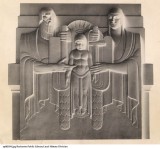Did you ever wonder how Rochester came to be and how it got its name?
The original inhabitants of the land surrounding Rochester were the Seneca Indians, one of the Six Nations of the Iroquois Confederacy, otherwise known as the Haudenosaunee (“The People of the Long House”).

A map of the Phelps and Gorham Purchase, second survey, showing the Genesee Valley from Lake Ontario to the Pennsylvania border.
When established as colonies by the British crown, both New York and Massachusetts laid claim to land occupied by the Seneca. In a treaty signed December 16, 1786, the two states resolved their differences. The land henceforth would be recognized as belonging to New York, but Massachusetts would have first rights to negotiate with the Indians for the land and settlement therein. Massachusetts later sold their rights to Oliver Phelps (October 21, 1749 – February 21, 1809) and Nathaniel Gorham (May 27, 1738 – June 11, 1796). The land comprised 6 million acres, spanning from the mouth of Sodus Bay to the Pennsylvania border.
While negotiating with the Seneca to release their claim to the land for white settlement, Oliver Phelps suggested that the Iroquois might benefit from a grist mill to grind their corn (a job traditionally done by the women of the tribe). When the Indians agreed to release 288 square miles for this purpose, Phelps gave 100 acres of the land to Ebenezer “Indian” Allan (September 17, 1752-April 13, 1813) to build both a grist and a saw mill. The grist mill was on Race Street between Aqueduct and Graves Streets in downtown Rochester, now the approximate location of the Thomson-Reuters Building (formerly Lawyer’s Cooperative Publishing Company, which fronts on Broad Street). The mill opened in 1789 but never prospered and soon was abandoned. Allen’s mill and the 100 acres of land surrounding it became the nucleus for what is today downtown Rochester.
Due to financial difficulties, Phelps and Gorham failed to meet their financial obligations to Massachusetts and the state reclaimed its rights to the land. The Commonwealth then sold its rights to Robert Morris (January 20, 1734 – May 8, 1806), a major financier of the American Revolution. An agent for Morris, Samuel Ogden, sold the land to a group of British investors known as the Pulteney Association.
Given the abortive efforts of Indian Allen’s mill, one can track Rochester’s real founding to the November 8, 1803 signing of a sales agreement between the Pulteney Association and the three co-founders of Rochester: Colonel Nathaniel Rochester (February 21, 1752 – May 17, 1831); Major Charles Carroll (November 7, 1767-October 28, 1823); and Colonel William Fitzhugh (1761-1839), all of Hagerstown, Maryland. The three friends had heard about the opportunity from Charles Williamson, an agent for the Pulteney Association (and for whom the town of Williamson, Wayne County, is named).

The three came north in October 1803 to review the land, and while speaking with agents for the Association asked about possible mill lots. They were directed to Indian Allen’s old property and explored the territory as far north as Hansford’s Landing (near the present intersection of Lake Avenue and West Ridge Road). Believing the area held promise, they agreed to purchase 100 acres for $1,750 ($17.50 per acre). The final payment was made June 22, 1808.
Rochester was the senior partner of the trio, and Carroll and Fitzhugh agreed to let Rochester take the lead in developing the town. Before serious development began in 1811, the settlement was referred to informally as “The Falls” or “Falls Town”; however, when the time came to formally name the community, the other partners agreed to name the village after the senior partner, so Rochesterville it became.
Whenever persons would later accuse Col. Rochester of vanity, he would reply wittily, “Should I call [the village] Fitzhugh or Carroll, the slighted gentleman would certainly feel offended with the other; but if I called it by my own name, they would most likely be angry with me; so, it is best to call it Rochester and serve both alike.” The New York State Legislature formally recognized and incorporated Rochesterville on March 21, 1817 (the “ville” suffix being dropped five years later).

Beginning of the act incorporating Rochesterville.
So, today, on the first day of spring, feel free to sing “Happy Birthday” to Rochesterville, the foundation for all we know today.
-Christopher Brennan

I guess I did know all of this, but I am familiar with it later called the
Flour City, due to the flour mills long the Genesee River. Obviously after the canal was dug.